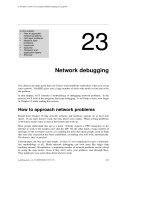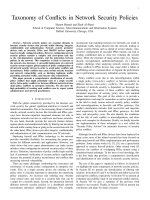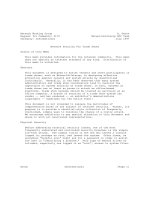Chapter 31 Network Security docx
Bạn đang xem bản rút gọn của tài liệu. Xem và tải ngay bản đầy đủ của tài liệu tại đây (968.77 KB, 49 trang )
31.1
Chapter 31
Network Security
Copyright © The McGraw-Hill Companies, Inc. Permission required for reproduction or display.
31.2
31-1 SECURITY SERVICES
31-1 SECURITY SERVICES
Network security can provide five services. Four of these
Network security can provide five services. Four of these
services are related to the message exchanged using the
services are related to the message exchanged using the
network. The fifth service provides entity authentication
network. The fifth service provides entity authentication
or identification.
or identification.
Message Confidentiality
Message Integrity
Message Authentication
Message Nonrepudiation
Entity Authentication
Topics discussed in this section:
Topics discussed in this section:
31.3
Figure 31.1 Security services related to the message or entity
31.4
31-2 MESSAGE CONFIDENTIALITY
31-2 MESSAGE CONFIDENTIALITY
The concept of how to achieve message confidentiality
The concept of how to achieve message confidentiality
or privacy has not changed for thousands of years.
or privacy has not changed for thousands of years.
The message must be encrypted at the sender site and
The message must be encrypted at the sender site and
decrypted at the receiver site. This can be done using
decrypted at the receiver site. This can be done using
either symmetric-key cryptography or asymmetric-key
either symmetric-key cryptography or asymmetric-key
cryptography.
cryptography.
Confidentiality with Symmetric-Key Cryptography
Confidentiality with Asymmetric-Key Cryptography
Topics discussed in this section:
Topics discussed in this section:
31.5
Figure 31.2 Message confidentiality using symmetric keys in two directions
31.6
Figure 31.3 Message confidentiality using asymmetric keys
31.7
31-3 MESSAGE INTEGRITY
31-3 MESSAGE INTEGRITY
Encryption and decryption provide secrecy, or
Encryption and decryption provide secrecy, or
confidentiality, but not integrity. However, on occasion
confidentiality, but not integrity. However, on occasion
we may not even need secrecy, but instead must have
we may not even need secrecy, but instead must have
integrity.
integrity.
Document and Fingerprint
Message and Message Digest
Creating and Checking the Digest
Hash Function Criteria
Hash Algorithms: SHA-1
Topics discussed in this section:
Topics discussed in this section:
31.8
To preserve the integrity of a document,
both the document and the fingerprint
are needed.
Note
31.9
Figure 31.4 Message and message digest
31.10
The message digest needs to be kept
secret.
Note
31.11
Figure 31.5 Checking integrity
31.12
Figure 31.6 Criteria of a hash function
31.13
Can we use a conventional lossless compression method
as a hashing function?
Solution
We cannot. A lossless compression method
creates a compressed message that is reversible.
Y ou can uncompress the compressed message to
get the original one.
Example 31.1
31.14
Can we use a checksum method as a hashing function?
Solution
We can. A checksum function is not reversible; it
meets the first criterion. However, it does not
meet the other criteria.
Example 31.2
31.15
Figure 31.7 Message digest creation
31.16
SHA-1 hash algorithms create an N-bit
message digest out of a message of
512-bit blocks.
SHA-1 has a message digest of 160 bits
(5 words of 32 bits).
Note
31.17
Figure 31.8 Processing of one block in SHA-1
31.18
31-4 MESSAGE AUTHENTICATION
31-4 MESSAGE AUTHENTICATION
A hash function per se cannot provide authentication.
A hash function per se cannot provide authentication.
The digest created by a hash function can detect any
The digest created by a hash function can detect any
modification in the message, but not authentication.
modification in the message, but not authentication.
MAC
Topics discussed in this section:
Topics discussed in this section:
31.19
Figure 31.9 MAC, created by Alice and checked by Bob
31.20
Figure 31.10 HMAC
31.21
31-5 DIGITAL SIGNATURE
31-5 DIGITAL SIGNATURE
When Alice sends a message to Bob, Bob needs to
When Alice sends a message to Bob, Bob needs to
check the authenticity of the sender; he needs to be
check the authenticity of the sender; he needs to be
sure that the message comes from Alice and not Eve.
sure that the message comes from Alice and not Eve.
Bob can ask Alice to sign the message electronically.
Bob can ask Alice to sign the message electronically.
In other words, an electronic signature can prove the
In other words, an electronic signature can prove the
authenticity of Alice as the sender of the message. We
authenticity of Alice as the sender of the message. We
refer to this type of signature as a digital signature.
refer to this type of signature as a digital signature.
Comparison
Need for Keys
Process
Topics discussed in this section:
Topics discussed in this section:
31.22
A digital signature needs a public-key
system.
Note
31.23
Figure 31.11 Signing the message itself in digital signature
31.24
In a cryptosystem, we use the private
and public keys of the receiver;
in digital signature, we use the private
and public keys of the sender.
Note
31.25
Figure 31.12 Signing the digest in a digital signature









